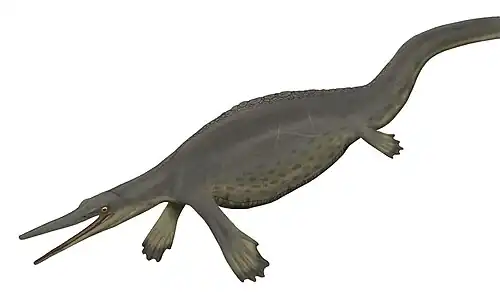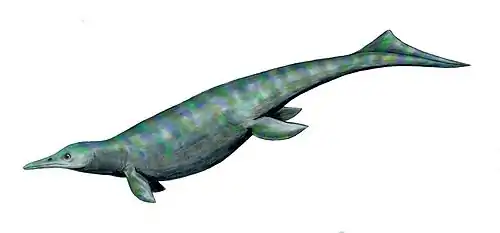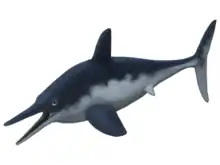Pachygonosaurus
Pachygonosaurus (meaning "wide angled [vertebrae] lizard")[1] is a genus of ichthyosaur from Upper Silesia, Poland (then part of the German Empire). It was described in 1916 by Friedrich von Huene and it has one single species, Pachygonosaurus robustus, based solely on the holotype, composed of two vertebral centra discovered in 1910, with a further three vertebrae also possibly belonging to the genus.[2] Nowadays, Pachygonosaurus is considered a nomen dubium.[3]
| Pachygonosaurus Temporal range: Ladinian, | |
|---|---|
 | |
| Vertebrae of Pachygonosaurus sp. | |
| Scientific classification | |
| Domain: | Eukaryota |
| Kingdom: | Animalia |
| Phylum: | Chordata |
| Class: | Reptilia |
| Order: | †Ichthyosauria |
| Genus: | †Pachygonosaurus von Huene, 1916 |
| Type species | |
| †Pachygonosaurus robustus Maisch and Matzke, 1997 | |
See also
References
- Maisch & Matzke 1997.
- von Huene 1916, pp. 39–40.
- Surmik & Brachaniec 2013, p. 93.
Cited bibliography
- von Huene, Friedrich (1916). "Beiträge zur Kenntnis der Ichthyosaurier im deutschen Muschelkalk". Palaeontographica (in German). Tübingen. 62: 1–68.
- Maisch, Michael W.; Matzke, Andreas T. (1997). "Observations on Triassic ichthyosaurs. Part I: Structure of the palate and mode of tooth implantation in Mixosaurus cornalianus (Bassini, 1886)". Neues Jahrbuch für Geologie und Paläontologie. Stuttgart. 1997 (12): 717–732. doi:10.1127/njgpm/1997/1997/717.
- Surmik, Dawid; Brachaniec, Tomasz (2013). "The large superpredators' teeth from Middle Triassic of Poland". Contemporary Trends in Geoscience. 2 (1): 91–94. Bibcode:2013CTGeo...2...91S. doi:10.2478/ctg-2014-0013. S2CID 59462364.
This article is issued from Wikipedia. The text is licensed under Creative Commons - Attribution - Sharealike. Additional terms may apply for the media files.







